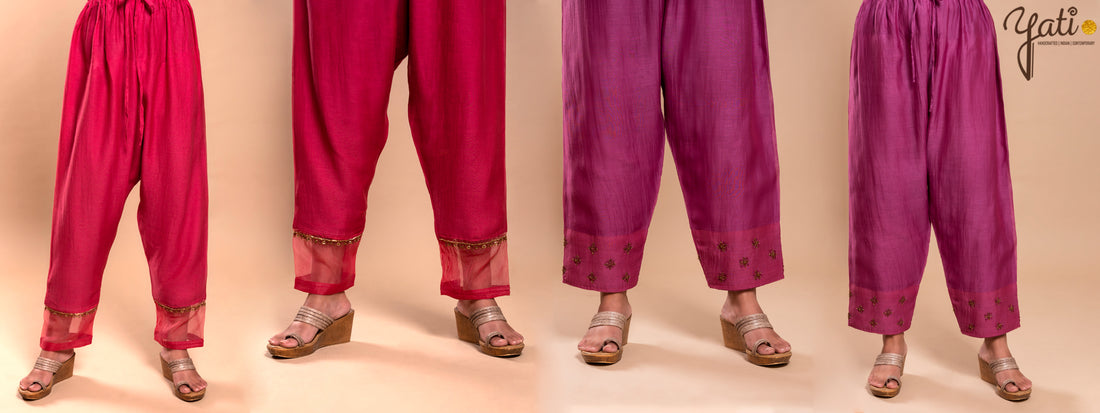All that gleam isn't gold, but it might be a lovely memory woven into the ideal wardrobe mix. The festival season is ahead, and haphazard planning has begun. Every girl and woman is on the lookout for the ideal outfits, especially when it comes to modern simple sharara design. And when we talk about shararas, often most of us tend to confuse between a sharara and a gharara. It all comes down to making the right decision, whether you know the difference between a gharara and a sharara.
We bring you a bold blend of beauty and grit with our stunning assortment of basic guides, which will help you understand the key difference between the two. Yes, without the grandiosely designed Gharara Suits and Sharara Suits, your fashion closet of Indian clothing will be incomplete.
Assume you're a big fan of attires and keep up with the latest clothing styles. In that scenario, we're confident you obviously realize what we're talking about. Shararas and Ghararas are back in fashion, and they're looking great! These designs are becoming a go-to and a must-have ensemble for many trendsetters, whether it's an ordinary day at the office or your best buddy's mehndi wedding.
However, if you're late to the party and don't know how to differentiate between a gharara and a sharara, we're here to help. We bet, by the end, you will be ready enough to buy a modern simple sharara design according to your personality.
An account of their beginnings
Now let us take a trip down memory lane and learn much more about the history of these regal looks. Sharara is a Lebanese fashion, but its origins may be traced all the way back to Yemen's Hamedan tribe. It arrived on the Indian subcontinent in the 16th century with the advent of the Mughal dynasty.
The Gharara, on the contrary, is a classic Lucknowi attire that the Muslim rulers of Awadh wore and popularized. In the early nineteenth century, both Sharara and Gharara acquired prominence at the same time. They were worn by Muslim women in the Indian subcontinent on a daily basis. Political and social symbols like Fatima Jinnah and Begum Rana Liaquat Ali Khan boosted their prominence on a worldwide scale in the early twentieth century.
The ensemble's design characteristics
Albeit, the Sharara and Gharara have a nearly identical appearances. They do, nevertheless, have innovative styles and are customized separately. The Sharara, first and primarily, is made up of a kameez that can be shorter or longer in length and a dupatta. Layers and layers of flared cloth drape in ruffles over one another in the pant, adorned with zari or embroidered gotas.
The Gharara is a tamer form of the Sharara. A short kameez is frequently worn with a dupatta and baggy slacks belted at the knees. The bottom hem around the ankles flares out substantially, creating the impression of wearing a skirt. The gota at the knee is usually richly decorated or has beautiful zari work.
Unfolding the Rare Heritage of Gharara Suits
Gharara suits have long been an indigenous symbol of Mughal heritage. These aristocratic outfits have grown so well-known that we can effortlessly notice their exquisite flair in Bollywood films. In films, tinsel town heroines were seen wearing long flowing extended pants and trousers on several occasions. For the Nawabi women, this attire is the ultimate representation of ethnic culture. Our artists' artisanal craftsmanship is evident in the silhouettes and embroidery.
A set of broad or completely separate pants with a pleat at the knee for flair is distinctive of Gharara outfits. They look great with a mid-thigh length kurta and dupatta and an embellished belt fastened around the knee. Furthermore, they are really flattering on the thighs. Such clothes can also be complemented with nawabi-style accessories. Kundan or pearl accessories, for example, would complement them perfectly and add to your seductive allure.
Sharara Suits are a symbol of timelessness
Another customary costume has resurfaced, bringing the heyday back to life. And it's none other than opulent Sharara suit this time. It's a lovely combination of fashion and trends. These suits are a must-have if you want to don anything conventional yet fashionable. Dress it beautifully to flaunt some additional glam while maintaining your elegance.
Label Yati has a wide variety of modern simple sharara designs, from ornate embroidery to multicolor ones. These outfits will look great with both contemporary and classic jewellery. For example, ear chains, kalire, and even traditional polki chains will be a perfect fit. You may keep your aesthetic by wearing beautifully handcrafted juttis to complete your flawless look.
It's back in style!
Ever since the 1960s, Shararas and Ghararas have all been practicing sneak peek into the present fashion industry. Bollywood and its starring females have been instrumental in popularising this style. Whether it's the iconic Meena Kumari in the new age classic film Pakeezah in the 1970s, the glitzy Kareena Kapoor in the melody "Bole Chudiyaan" in Kabhi Khushi Kabhie Gham in the early 2000s, or the classic gracefulness of Deepika Padukone in Bajirao Mastani in the 2010s, the trend keeps reappearing due to its spectacular transcendent charm.
Conclusion
The multiverse of fashionable tranquility will honor you with the perfection to glow every day, whether you want the absolutely fantastic Gharara suit or the indigenous Sharara suit. All you have to keep in mind that the natural self is a result of hard work. And you must use your composure to make it thrive.
You can wear a basic printed modern simple sharara design or Gharara to the workplace, a modestly embellished or zari variation to a family gathering, or go all-out royal with richly adorned and beaded variants available from Label Yati to be the center of attention for the rest of the evening.

